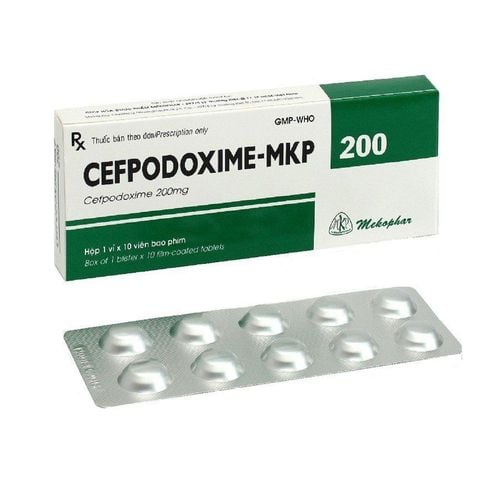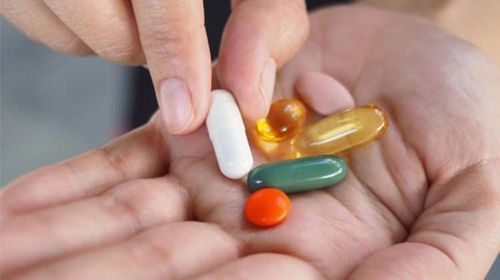This is an automatically translated article.
Bloci is an antibiotic of the quinolone group that has the ability to treat infections of the respiratory tract, digestive tract, urinary tract, genitals, bones and joints and many other diseases. To learn about the ingredients, uses, and instructions for using the drug, please refer to some of the information shared in the article below.
1. What is Bloci and how does it work?
Bloci drugs are imported and distributed genuine in Vietnam. The main ingredient of the drug is Ciprofloxacin with a strength of 500mg, made in the form of film-coated tablets.
This is a quinolone antibiotic with a broad spectrum of action, distinguished by its ability to inhibit the gyrase enzyme of bacterial cells, preventing bacteria from growing. It is used to treat serious infections for which conventional antibiotics are not effective.
2. Indications and contraindications of the drug Bloci
2.1. Indication of the above-mentioned Bloci drug should be indicated in cases of infections of the respiratory tract, ENT, kidney or urinary tract. In addition, the drug is suitable for the treatment of genital tract infections including gonorrhea. The drug is also effective with infections of the gastrointestinal tract, bile ducts, bones and joints, soft tissues, obstetrics and gynecology, blood infections, people with meningitis, peritonitis, eye infections. In some cases, the drug is used to prevent meningococcal disease and bacterial infections in immunocompromised people.
2.2. Contraindications Bloci is contraindicated in patients with a history of hypersensitivity to ciprofloxacin and nalidixic acid or other quinolones.
Pregnant and lactating people absolutely do not use the drug.
3. How to use and dose of Bloci
Bloci drug is used orally, patients can take the drug before or after meals. However, if you want the drug to be absorbed quickly, you should pay attention to take it 1-2 hours after a meal.
The duration of treatment with Bloci depends on the type of infection and the severity of the disease. In general, the drug is only used for adults with reference doses as follows:
Patients with mild and moderate infections: Use with a dose of 250 - 500mg, twice a day. Patients with severe infections and complications: Use with a dose of 750mg, twice a day. Use the drug for 5 to 10 days. Patients with renal failure ClCr 30-50 mL/min: Use at a dose of 250-500 mg/12 hours. Patients with renal failure ClCr 5 - 29 mL/min: Use at a dose of 250 - 500 mg/18 hours. Patients on dialysis: Use at a dose of 250-500 mg/24 hours.
4. Bloci drug side effects
During the use of Bloci, some unwanted effects may occur including:
Digestive disorders leading to nausea, vomiting, flatulence, dyspepsia, abdominal pain... Allergic reactions appear rash, pruritus, rash. Some cases appear signs of headache, dizziness, dizziness, liver dysfunction. Patients may also experience muscle pain, joint pain... During the course of taking Bloci, if you see any of the above undesirable effects, you need to stop using the drug immediately and notify your doctor for support. timely.
5. Drug Interactions Bloci
Bloci can interact with some of the following drugs:
Non-steroidal anti-inflammatory drugs (Including ibuprofen, indomethacin...) will increase the side effects of Bloci. Antacids containing aluminum and magnesium will decrease serum concentrations and decrease the bioavailability of Bloci. Therefore, you need to take these medicines apart from each other (antacids should be taken 2 - 4 hours before taking Bloci). Absorption of Bloci may be halved if certain cytotoxic drugs are administered concurrently, including cyclophosphamide, vincristine, doxorubicin, cytosine arabinoside and mitoxantrone. Didanosine reduces the effectiveness of Bloci significantly. Bloci should be taken 2 hours before Didanosin or 6 hours after Didanosin. Iron preparations such as fumarate, gluconate, and sulfate also have the risk of significantly reducing the intestinal absorption of Bloci. Sucralfate will reduce the absorption of Bloci significantly, so it should be taken 2-6 hours apart. Concomitant use with Theophylline may increase the serum concentration of Theophylline, causing side effects of Theophylline. If the use of both drugs is mandatory, the patient should have blood levels of Theophylline checked and the Theophylline dose reduced if necessary. Concomitant use with Cyclosporin may cause a transient increase in serum creatinine, so the patient should be checked for serum creatinine twice a week. Probenecid reduces the glomerular filtration rate and tubular secretion, thereby reducing the excretion of the drug Bloci in the urine.
6. Some notes when using Bloci
Do not drink alcohol or caffeinated drinks such as coffee, tea, energy drinks, soft drinks or chocolate while taking the medicine.
Care should be taken when using Bloci, for people with a history of seizures or central nervous system disorders.
Use caution in patients with impaired liver or kidney function, glucose 6 phosphate dehydrogenase deficiency, and myasthenia gravis.
Long-term use of Bloci may cause overgrowth of bacteria that are not sensitive to the drug. Therefore, patients need to be monitored for their health and have regular antibiotics to have appropriate treatment according to the antibiotic chart.
Above is some information about the drug Bloci that readers can refer to. Patients need to take the drug after consulting a specialist, taking the medicine exactly as prescribed to achieve the best effect.
Please dial HOTLINE for more information or register for an appointment HERE. Download MyVinmec app to make appointments faster and to manage your bookings easily.













